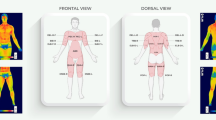Abstract
Heat dissipation during sport exercise is an important physiological mechanism that may influence athletic performance. Our aim was to test the hypothesis that differences exist in the dynamics of exercise-associated skin temperature changes between trained and untrained subjects. We investigated thermoregulation of a local muscle area (muscle–tendon unit) involved in a localized steady-load exercise (standing heels raise) using infrared thermography. Seven trained female subjects and seven untrained female controls were studied. Each subject performed standing heels raise exercise for 2 min. Thermal images were recorded prior to exercise (1 min), during exercise (2 min), and after exercise (7 min). The analysis of thermal images provided the skin temperature time course, which was characterized by a set of descriptive parameters. Two-way ANOVA for repeated measures detected a significant interaction (p = 0.03) between group and time, thus indicating that athletic subjects increased their skin temperature differently with respect to untrained subjects. This was confirmed by comparing the parameters describing the speed of rise of skin temperature. It was found that trained subjects responded to exercise more quickly than untrained controls (p < 0.05). In conclusion, physical training improves the ability to rapidly elevate skin temperature in response to a localized exercise in female subjects.




Similar content being viewed by others
References
Bertmaring, I., K. Babski-Reeves, and M. A. Nussbaum. Infrared imaging of the anterior deltoid during overhead static exertions. Ergonomics 51:1606–1619, 2008.
Brengelmann, G. L., J. M. Johnson, L. Hermansen, and L. B. Rowell. Altered control of skin blood flow during exercise at high internal temperatures. J. Appl. Physiol. 43:790–794, 1977.
Ferreira, J. J. A., L. C. S. Mendonça, L. A. O. Nunes, A. C. C. Andrade Filho, J. R. Rebelatto, and T. F. Salvini. Exercise associated thermographic changes in young and elderly subjects. Ann. Biomed. Eng. 36:1420–1427, 2008.
Flanagan, S. P., J.-E. Song, M.-Y. Wang, G. A. Greendale, S. P. Azen, and G. J. Salem. Biomechanics of the heel-raise exercise. J. Aging Phys. Act. 13:160–171, 2005.
Fritzsche, R. G., and E. F. Coyle. Cutaneous blood flow during exercise is higher in endurance-trained humans. J. Appl. Physiol. 88:738–744, 2000.
Hébert-Losier, K., R. J. Newsham West, A. G. Schneiders, and S. J. Sullivan. Raising the standards of the calf-raise test: a systematic review. J. Sci. Med. Sport 12:594–602, 2009.
Jensen, L., J. Bangsbo, and Y. Hellsten. Effect of high intensity training on capillarization and presence of angiogenic factors in human skeletal muscle. J. Physiol. 557:571–582, 2004.
Johnson, J. M. Exercise and the cutaneous circulation. Exerc. Sport Sci. Rev. 20:59–97, 1992.
Jones, B. F., and P. Plassmann. Digital infrared thermal imaging of human skin. IEEE Eng. Med. Biol. Mag. 21:41–48, 2002.
Kenney, W. L., and J. M. Johnson. Control of skin blood flow during exercise. Med. Sci. Sports Exerc. 24:303–312, 1992.
Lahiri, B. B., S. Bagavathiappan, T. Jayakumar, and J. Philip. Medical applications of infrared thermography: a review. Infrared Phys. Technol. 55:221–235, 2012.
Ludwig, N., R. Cabrini, F. Faoro, M. Gargano, S. Gomarasca, M. Iriti, V. Picchi, and C. Soave. Reduction of evaporative flux in bean leaves due to chitosan treatment assessed by infrared thermography. Infrared Phys. Technol. 53:65–70, 2010.
Ludwig, N., M. Gargano, D. Formenti, D. Bruno, L. Ongaro, and G. Alberti. Breathing training characterization by thermal imaging: a case study. Acta Bioeng. Biomech. 14:41–47, 2012.
Merla, A., P. Iodice, A. Tangherlini, G. De Michele, S. Di Romualdo, R. Saggini, and G. Romani. Monitoring skin temperature in trained and untrained subjects throughout thermal video. Conf. Proc. IEEE Eng. Med. Biol. Soc. 2:1684–1686, 2005.
Merla, A., P. A. Mattei, L. Di Donato, and G. L. Romani. Thermal imaging of cutaneous temperature modifications in runners during graded exercise. Ann. Biomed. Eng. 38:158–163, 2010.
Robinson, S. Temperature regulation in exercise. Pediatrics 32(Suppl):691–702, 1963.
Rowell, L. B. Blood pressure regulation during exercise. Ann. Med. 23:329–333, 1991.
Torii, M., M. Yamasaki, T. Sasaki, and H. Nakayama. Fall in skin temperature of exercising man. Br. J. Sports Med. 26:29–32, 1992.
Zaïdi, H., R. Taïar, S. Fohanno, and G. Polidori. The influence of swimming type on the skin-temperature maps of a competitive swimmer from infrared thermography. Acta Bioeng. Biomech. 9:47–51, 2007.
Zontak, A., S. Sideman, O. Verbitsky, and R. Beyar. Dynamic thermography: analysis of hand temperature during exercise. Ann. Biomed. Eng. 26:988–993, 1998.
Acknowledgments
We thank Letizia Bonizzoni PhD, Dr Gabriele Boccolini, and Dr Giada Pavia for the technical assistance, and the Synchronized Swimming Team Sincro Seregno for cooperation and support.
Author information
Authors and Affiliations
Corresponding author
Additional information
Associate Editor Joel D. Stitzel oversaw the review of this article.
Rights and permissions
About this article
Cite this article
Formenti, D., Ludwig, N., Gargano, M. et al. Thermal Imaging of Exercise-Associated Skin Temperature Changes in Trained and Untrained Female Subjects. Ann Biomed Eng 41, 863–871 (2013). https://doi.org/10.1007/s10439-012-0718-x
Received:
Accepted:
Published:
Issue Date:
DOI: https://doi.org/10.1007/s10439-012-0718-x




